When the weather cools in fall, it’s time to plant spring-blooming bulbs. Most of the familiar ones are from faraway places: tulips have their origins in the Mediterranean region and Asia Minor (Turkey), and daffodils originate from southwestern Europe. There are a number of bulbs that hail from North America, but they are less commonly used. Among these natives are more than 100 species of alliums. Most native alliums originate in western or midwestern parts of North America. Nodding onion (
Allium cernuum) is one of the few allium species whose native range includes the eastern United States.
This native onion is compact and produces beautiful flowers in the middle of summer. It prefers full sun and does well in average to dry soil. It also has few pest problems, making it an excellent candidate for a low-maintenance garden or border.
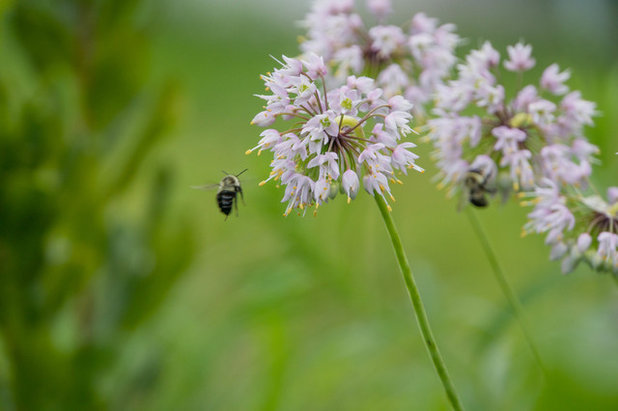 Photo by rockerBOO, Flickr
Photo by rockerBOO, Flickr
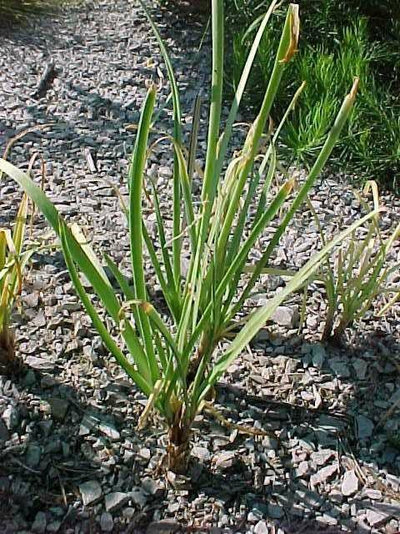
Missouri Botanical Garden
Botanical name: Allium cernuumCommon name: Nodding onion
Origin: From New York south to the cooler regions of Georgia and west to British Columbia and Arizona
Where it will grow: Hardy to -40 degrees Fahrenheit (USDA zones 3 to 8; find your zone)
Water requirement: Dry to medium moisture
Light requirement: Full to partial sun
Mature size: The foliage typically grows to 12 inches, and the flower stalk reaches about 18 inches.
Benefits and tolerances: Like most alliums, nodding onion is not significantly bothered by deer and other mammalian herbivores, like moles. It also tolerates dry soils, drought, shallow and rocky soils and can grow under a black walnut tree. This species is a larval host for the hairstreak butterfly; the flowers attract butterflies and bees that don’t mind feeding on the inverted flowers.
Shown: A single plant that will grow into a clump as the bulb produces offsets
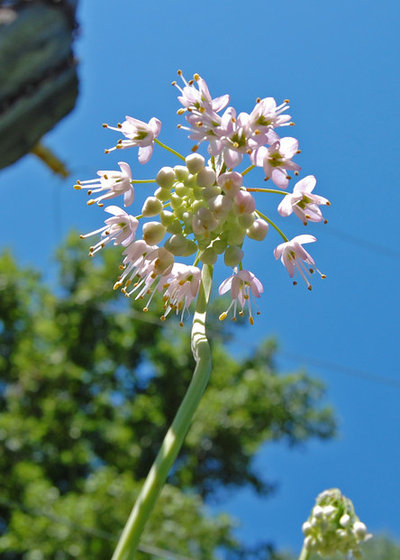 Seasonal interest:
Seasonal interest: Blooming time is between June and August. The seed heads persist into the fall; the foliage also persists to act as a lawn border well into fall.
When to plant: Seeds are best planted in the spring; however, planting bulbs in fall generally gives better results. Nodding onion bulbs should be put in at the same time as other spring-blooming bulbs.
Shown: A flower head in late July
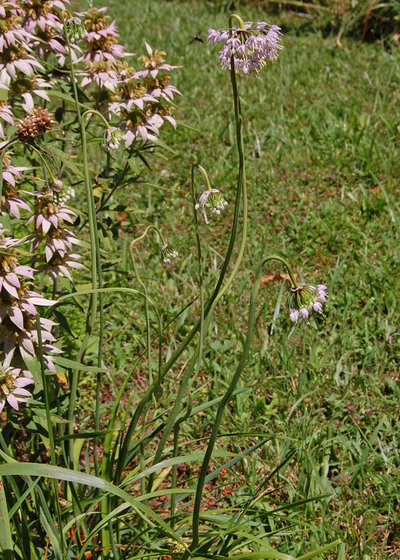 Distinguishing traits
Distinguishing traits. White to pink umbels (flower heads) bend toward the ground at the end of the stem, hence the name nodding onion. The leaves are flat and grass-like, with a mild, oniony scent. While the leaves of cultivated onion and field garlic are hollow, the leaves of nodding onion are solid. Nodding onion is generally edible, in moderation, tasting similar to garlic. The edible parts include the leaves, bulbs and bulblets. The leaves may be harvested for uses similar to those for chives, in spring and fall.
A new cultivar called ‘Wine Drop’ was introduced in 2013. It has pink flowers with red pedicels (the little stems that connect the flower to the flower stalk). There are two white-flowered cultivars, called ‘Leo’ and ‘Oxy White’. The nodding form of the flower heads distinguishes it from many other ornamental alliums, such as the upright globemaster allium (
Allium ‘Globemaster’). Autumn onion (
A. stellatum) is a midwestern native that can also be distinguished from nodding onion by its upright flower heads and its generally later blooming time.
Shown: Typical nodding flower heads
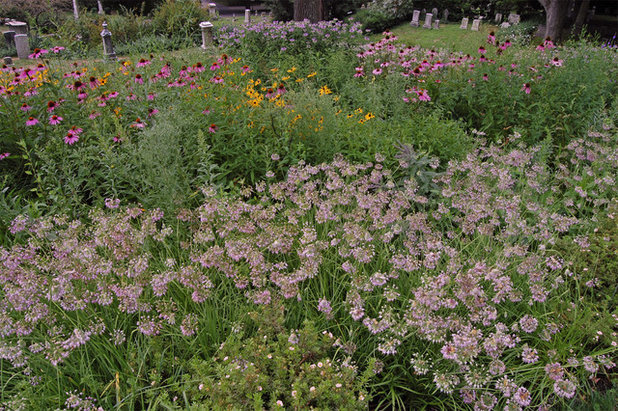 How to use it.
How to use it. The dense, upright foliage of nodding onion makes it a good border or edging plant. Consider using it as a border edging in place of nonnative species like liriope or mondo grass. These introduced species are evergreen and do better in shady locations with average soil moisture. They are cold hardy to zones 6 and 7, respectively. Nodding onion is better for full to partial sun in dryish soils. It is also cold hardier. The flowers of nodding onion are showier, and it offers more benefits to wildlife. However, the relatively taller foliage does give it a wilder appearance.
Intersperse clumps around the garden where the foliage can be used to hide the browning foliage of early spring ephemerals and bulbs, like tulips and narcissi. The plant also acts as a deterrent for moles. I am incorporating it in a border around a vegetable garden to help control animal pests.
Here a 1- to 2-foot-wide border of nodding onion separates a lawn area from a wildflower meadow containing wild bergamot (
Monarda fistulosa)
and purple and yellow coneflowers (
Echinacea spp).

Here we see the previous garden from above. Shrubby cinquefoil (
Potentilla fruticosa) is mixed in with the onion.
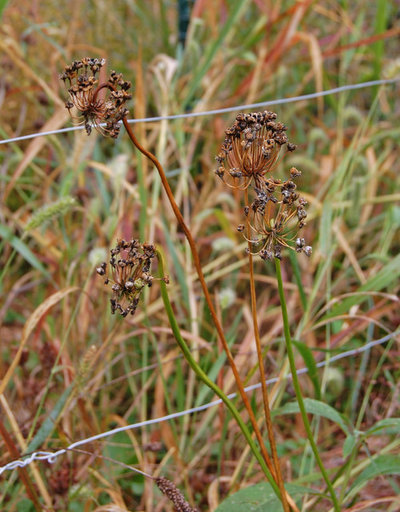 Planting notes.
Planting notes. Nodding onion likes neutral to alkaline soils. These conditions are consistent with maintaining a healthy lawn. So using it next to, or even within, a lawn could work. However, like most alliums and bulbs in general, it does not like to be in a consistently moist soil.
It takes two to three years to grow a flowering plant from seed. Existing masses are best divided every three years, when the plants are dormant (in late fall or early spring). Nodding onion reseeds readily, and plant masses expand underground by bulb offsets. It should be deadheaded to control its spread by reseeding, if desired.
Shown: Seeds ripening in September





